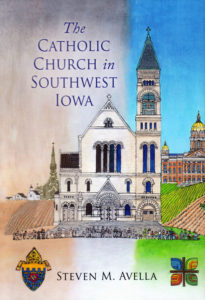By Timothy Walch
Imagine, if you will, that the most important Catholic in the world decided to visit your diocese! How would you plan for such a visit? Where would you hold a Mass for say, 350, 000 people?
That was the challenge and the opportunity embraced by Bishop Maurice Dingman when he learned that His Holiness Pope John Paul II would honor the people of Iowa and the American heartland with a visit on Oct. 4, 1979.

Author Timothy Walch reviews the book “The Catholic Church in Southwest Iowa,” which is written by Father Steven Avella.
The story of that historic day — and all the planning that preceded it — is told with verve and clarity in the closing chapter of a new book that will be of interest to Catholics across the country. “The Catholic Church in Southwest Iowa” was issued recently by Liturgical Press and is available from booksellers and on the Internet for $24.95 plus shipping.
Father Steven Avella, a professor of history at Marquette University, traces the history of the Diocese of Des Moines from its earliest days as a cluster of parishes in Iowa’s capital city to its elevation as a diocese in 1911 and on to the papal visit. The book traces an important and often overlooked story of the trials and triumphs of Catholics on the American prairie.
That this book will have an important impact on how we understand the achievement of the church in this country is evident in early reviews. Historians and scholars have reviewed Fr. Avella’s work and saluted his ability to bring together the story of a diocese of small cities and big towns bound together by hundreds of bustling farms.
No less a church leader than Cardinal Timothy Dolan, the Archbishop of New York and a trained historian himself, weighed in with this assessment: ”Father Steven Avella has produced a serious, thoughtful and engaging history. … This book shows how the people of the Catholic Church in the Diocese of Des Moines has offered the love of Jesus Christ to the poor, the immigrant, and the farmer for over 100 years. After reading this compelling history of Catholics in southwest Iowa, one can only hope that future harvest will be just as fruitful.” That is quite an endorsement from a Prince of the Church.
The book is divided into nine engaging chapters that begin with the frontier days of the church in Iowa and introduce readers to the committed clergy, professed religious and determined lay people who shaped Des Moines Catholicism until 1911 when southwest Iowa parishes were clustered into a new diocese under Bishop Austin Dowling. Subsequent chapters are organized around the tenures of Bishops Thomas Drumm, Gerald Bergan, Edward Daly and Maurice Dingman.
The book concludes with that chapter on the papal visit. “The providence of God is very evident in this knoll and in all of rural America,” noted Bishop Dingman, as the pope arrived by helicopter at Living History Farms, the site of the historic liturgical celebration. It was a day that will live forever in the history of American Catholicism in general and Iowa Catholicism in particular.
Although it is Fr. Avella who deserves the credit for this remarkable work, he would be quick to thank Bishop Richard Pates, diocesan officials Adam Storey and Jason Kurth, and the generosity of the Edwin T. Meredith Foundation in facilitating his achievement. All for the greater glory of God.
(Reviewer Timothy Walch is a member of St. Thomas More Parish in Coralville and the author of many books on the history of American Catholicism including “Parish School” (2016). He serves on The Catholic Messenger Board of Directors.)











